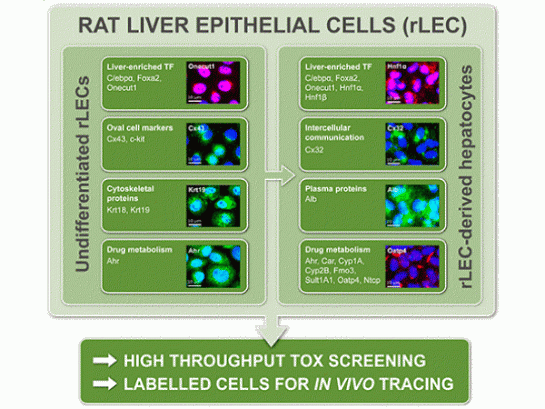Rat liver epithelial cells (rLECs), originally derived from neonatal animals, have been used as helper cells in co-culture of primary hepatocytes. Our group has shown that rLECs stably express markers typical for hepatic progenitors, namely liver-enriched transcription factors, oval cell markers, cytoskeletal proteins and drug metabolism regulators. Undifferentiated rLECs demonstrate a stable expression of these markers for at least 15 consecutive passages.

When exposed to hepatogenic growth factors and cytokines according to proprietary protocol(EP2041272B1), hepatocytes-like cells are obtained that demonstrate phenotypical features of functional hepatocytes, namely;
- expression and nuclear localization of transcription factors typical for mature hepatocytes,
- expression and polarization of drug transporters, increased expression of drug metabolizing enzymes and their regulators,
- the level of selected cytochrome P450-dependent activities comparable to that of freshly isolated hepatocytes, which in this respect are considered the golden standard,
- and finally the expression of a typical hepatocellular communication protein and plasma protein albumin,
Also improved expression of carbohydrate, lipid, vitamin and mineral metabolism markers was evidenced. Above-mentioned liver-like functions can be maintained for a period of several weeks.
Researchers
Prof. Joery De Kock
Dr. Robim M. Rodrigues
Phd Student Jennifer Bolleyn
Associated Projects
Relevant Publications
- Snykers S., De Kock J., Vanhaecke T. and Rogiers V. (2007) Differentiation of neonatal rat epithelial cells from biliary origin into immature hepatic cells by sequential exposure to hepatogenic cytokines and growth factors reflecting liver development. Toxicol In Vitro 21(7): 1325-1331.
- De Kock J., Snykers S., Branson S., Jagtap S., Gaspar J.A., Sachinidis A., Vanhaecke T., Rogiers V. (2012) “A liver-derived rat epithelial cell line from biliary origin acquires hepatic functions upon sequential exposure to hepatogenic growth factors and cytokines”. Current Medicinal Chemistry, 19(26): 4523-4533.
